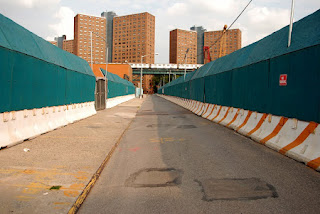“This twenty-first-century urbanity [of the Manhattanville extension project] is in direct contrast to the twentieth-century version that created the character and “gravitas” of the Morningside campus. The introspection and formality of this classic space created a magnificent presence. But it was one conceived as fundamentally separate from the surrounding city. In Manhattanville, we envision the energy of the city and academy flowing together. We hope this will create a place that is simultaneously “campus” and “not campus”” (Taylor 52).
But the transformation of a landscape (and even more, of the relationships of the people living in it) is obviously not just about the difference between what was before, and what is after. It is not only about the end result of spatial management and integration. It includes elements that are also temporal, active and social. It is about the transformation process itself – in this case, the period of time during which the area is under construction – and the social and political relationships that are produced, suppressed, and negotiated through the experience of living in that change.
Perhaps this is why a quick perusal of news coverage of the project over the past few years does not return many discussions of the final vision, critiques of the proposed design itself, or reflections on its historical comparability to the existing campus. Instead, and indeed somewhat predictably, I found criticisms of the intrusion of construction on daily lives, of enforced displacements, and of the shortcomings of administrative responses to these concerns that typically took “big picture” views. Furthermore, the complaints I read are not, as one might expect, primarily about the visual unpleasantness of waking up to a skyline of cranes, or walking past giant sinkholes. Instead, the complaints draw attention to other ways of knowing and living in an urban construction zone that emphasize its multi-sensory and multi-elemental nature – aspects of life that are not apparent in pristine urban design drawings and mock-ups, or from aerial views of that remove one bodily from the scene.In attempting to break down aesthetic boundaries as seen from outside and above, the project may well be re-inscribing numerous emotional and psychological ones.
I give two examples of affected non-visual aspects of the landscape here.
 First, in the rush to examine the construction areas themselves, one might easily miss the very space that allows their examination: the streets.
First, in the rush to examine the construction areas themselves, one might easily miss the very space that allows their examination: the streets.
You can find a list of planned closures and restrictions to streets (and consequently, movement through them) here. The list is not short, or uncomplicated. It requires one to consider the complex and often subconscious ways in which movement through a changing landscape reinforces one’s relationship to it, and how enforced changes to that relationship recreate power struggles and inequalities that are re-experienced every day.
Henri Lefebvre wrote that “Power seeks to control space in its entirety, so it maintains it in a ‘disjointed unity,’ as at once fragmentary and homogenous: it divides and rules” (Lefebvre 388).
What more effective way to divide and homogenize than to close and alter roadways? Streets are the spaces that allow movement from one place to another, that bring people together through and across a landscape, even as they emphasize the distinction between being in one place or another. When they are closed, all of the daily activities of life – businesses, commutes, leisurely strolls, shopping excursions – must be subordinated to the ends of the project. To close a road while subsuming the area around it into the university’s domain seems the ultimate example of Lefebvre’s observation.
The second example comes from an intended response to the first. As stated on the page linked above, New York City does not allow work on intersections during daylight hours, presumably to minimalize the spatial impact discussed (as well as, in all likelihood, for its own convenience, as the traffic from backed-up intersections would be much more difficult to manage and re-route). This means that as of February 13, work at the intersection of W 125th St and 12th Ave will take place between the hours of 10:00 pm and 5:00 am.

I quote, “This will include some noisy work.” This is clearly a problematic logistics issue, and I can imagine that once the decision to do work is taken, the scheduling of relative inconveniences is difficult. However, it does provoke consideration of the choice, a joint maneuver of city and developers, in the overall context of the project. Night construction provides yet another way in which the activity of transformation invades and re-structures local lives; noise pollution is always part of city living, and noise always refuses to stay outside, pushes itself past other physical boundaries and makes itself known wherever it finds itself. However, now this noise will not be confined even to daylight hours, when one expects to encounter the greater part of the rest of city noise. Yet another boundary is disregarded, and therefore thrown into high relief.
I conclude with another quote from Taylor, who writes that with the accomplishment of the expansion project, “The boundaries between the academy and the workplace will become less defined. So too will the distance between the city and the academy diminish. This will create a new urbanity, energized by learning, characterized by interaction” (Taylor 53). I cannot help wondering who is identifying the boundaries to be (un)defined, and the distances to be diminished, and to whose advantage the closing of this landscape might be.
Photo credits: Nathan Kensinger – more photos of the demolition can be seen here: http://kensinger.blogspot.com/2011/08/demolition-of-manhattanville.html
Drawing credits: Skidmore, Owings & Merrill with Renzo Piano Building Workshop
Cited works:
Lefebvre, Henri, 1974. The Production of Space. Donald Nicholson-Smith (Transl). Malden, MA: Blackwell Publishing Edition, 2011.



No comments:
Post a Comment